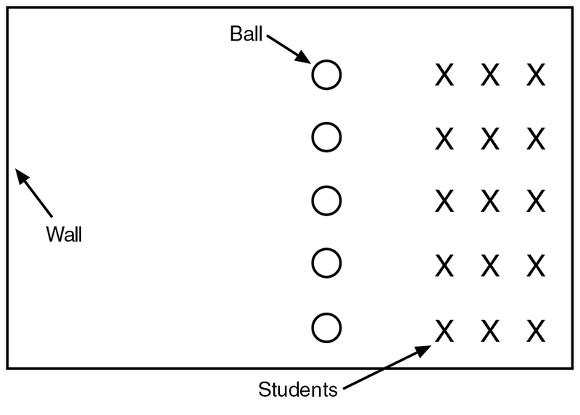Group Activities
Keep the Balls Out of the Middle
Objective
To practice kicking and trapping a ball.
Equipment
A very large play area and one to four foam balls (8 inches [20.3 cm] in diameter) or other soft balls. The number of balls needed will vary based on the skill level of the students.
Activity
- Divide the class into two groups.
- Place one group in the center of a large circle and the other group outside of the circle.
- On your start signal, the students on the outside roll the balls into the circle. The students inside the circle must stop (trap) the balls and then kick them back outside of the circle.
- The students on the outside retrieve the balls, return to their positions, and roll the balls into the circle again; then the activity continues.
- Have the two groups change places after 1 to 2 minutes.
Extensions
- Tally the total number of correct kicks for each group. You may choose to chart these or record them to serve as a target to improve on in a later lesson.
- Tally the total number of correct kicks for the entire class. The class should try to increase their total correct kicks each time they play the activity.
- Observe the students while they are playing. Tell any student having trouble kicking correctly to go to the practice area and work with a partner.
- Have the students kick the balls without stopping them.
Create Your Own Activity
Objective
To allow students to create their own activities to reinforce the skill of kicking.
Equipment
One piece of paper and pencil per group and a predetermined list of equipment you will allow the students to use in their activities (e.g., playground balls, cones, hoops).
Activity
- Form groups of two to five students. You may select the groups, or the students may form their own.
- Each group creates an activity using the kick as the basic skill. Students are required to have rules that encourage correct performance of the skill, include all players, and address all safety concerns.
- The groups write their individual names, the rules of the activity, and the equipment needed on their papers, and then they give their activities to you.
- After you approve their activities, the groups retrieve the necessary equipment and begin playing.
- You must approve all changes to the activities.
Extensions
- Groups may teach their activities to other groups.
- Groups may teach their activities to the entire class.
Kick and Go
Objective
To kick balls of various sizes.
Equipment
A variety of balls that can be kicked (e.g., playground balls of different colors, soccer balls of different sizes, foam balls). No two balls should be identical.
Activity
- Place students in lines of three with a ball in front of each line (see figure).
- On the start signal, the first student in each line stands up, approaches the ball, and kicks it as far as he can. For safety, a start command must be used for each rotation.
- This student then runs to retrieve a kicked ball. He may not return with the same ball that he kicked.
- The student hands the ball to the next student in line.
- The activity continues through several rotations.

Setup for Kick and Go activity.
Extensions
- Students dribble the balls back to the line.
- The student must name the type of ball he retrieved. Other members of the line are allowed to help if needed.
Based on Bryant and McLean Oliver 1975.
